
The Palazzo Pitti, in English sometimes called the Pitti Palace, is a vast, mainly Renaissance, palace in Florence, Italy. It is situated on the south side of the River Arno, a short distance from the Ponte Vecchio. The core of the present palazzo dates from 1458 and was originally the town residence of Luca Pitti, an ambitious Florentine banker.

The Bargello, also known as the Palazzo del Bargello, Museo Nazionale del Bargello, or Palazzo del Popolo, was a former barracks and prison, now an art museum, in Florence, Italy.

Palazzo Strozzi is a palace in Florence, Italy.

Piazza dei Cavalieri is a landmark in Pisa, Italy, and the second main square of the city. This square was the political centre in medieval Pisa. After the middle of 16th century the square became the headquarters of the Order of the Knights of St. Stephen. Now it is a centre of education, being the main house of the Scuola Normale di Pisa, a higher learning institution part of the University.

The Palazzo delle Assicurazioni Generali is a building in the Piazza della Signoria in Florence, Italy. Originally the Palazzo Fenzi, built for the Fenzi banking family and designed in the Neo-Renaissance style by Giuseppe Martelli and is one of the very few purpose built commercial buildings in the centre of the city though it housed on the upper floors reception rooms for the Fenzi family.

Palazzo Spini Ferroni is a large Gothic palace located along Via de' Tornabuoni at the corner of Piazza Santa Trinita, in central Florence, region of Tuscany, Italy. It stands across from the church of Santa Trinita.
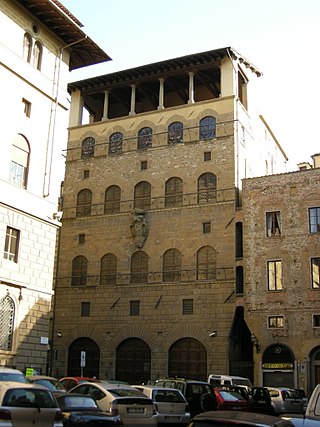
Palazzo Davanzati is a palace in Florence, Italy. It houses the Museum of the Old Florentine House.

The Vasari Corridor is an elevated enclosed passageway in Florence, central Italy, connecting the Palazzo Vecchio with the Palazzo Pitti. Beginning on the south side of the Palazzo Vecchio, it joins the Uffizi Gallery and leaves on its south side, crossing the Lungarno dei Archibusieri, then following the north bank of the River Arno until it crosses the river at Ponte Vecchio. At the time of construction, the corridor had to be built around the Torre dei Mannelli, using brackets, because the tower's owners refused to alter it. The corridor conceals part of the façade of the Church of Santa Felicità. It then snakes its way over rows of houses in the Oltrarno district, becoming narrower, to finally join the Palazzo Pitti. The corridor's full length is approximately one kilometre.

The Monash University Prato Centre is a teaching and research centre in Tuscany. It is located in an 18th-century palace, the Palazzo Vaj, in the historical centre of Prato. It was opened on 17 September 2001, as part of Monash University's internationalisation policy. It was established with the assistance of the local government of Prato, the region of Tuscany and prominent Italian-Australians Rino and Diana Grollo.
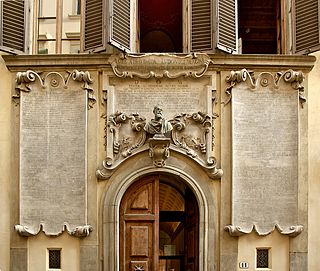
Palazzo dei Cartelloni, also known as Palazzo Viviani, is a Baroque-style palace in Florence, region of Tuscany, Italy.
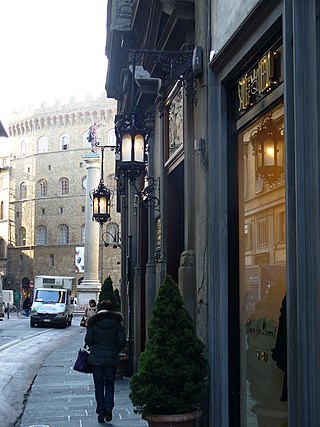
Via de' Tornabuoni, or Via Tornabuoni, is a street at the center of Florence, Italy, that goes from Antinori square to ponte Santa Trinita, across Santa Trinita square, distinguished by the presence of fashion boutiques.
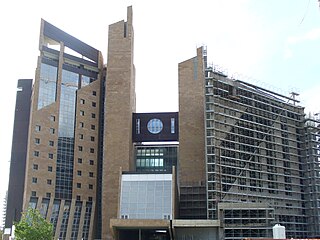
The Florence Courthouse is a large 21st-century complex on the Viale Guidoni in the Novoli quarter of Florence, Tuscany, Italy.

Piazza del Duomo is located in the heart of the historic center of Florence. It is one of the most visited places in Europe and the world and in Florence, the most visited area of the city. The square contains Florence Cathedral with the Cupola del Brunelleschi, the Giotto's Campanile, the Florence Baptistery, the Loggia del Bigallo, the Opera del Duomo Museum, and the Arcivescovile and Canonici's palace. The west zone of this square is called Piazza San Giovanni.

Piazza Santa Croce is one of the main plazas or squares located in the central neighbourhood of Florence, in the region of Tuscany, Italy. It is located near Piazza della Signoria and the National Central Library, and takes its name from the Basilica of Santa Croce that overlooks the square.
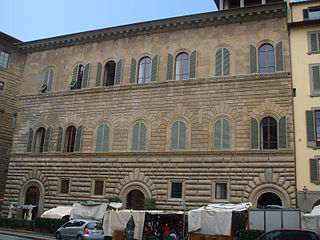
Palazzo Gondi is a palace in Florence, Italy, located a block from Piazza della Signoria. It was built in 1490 under design by Giuliano da Sangallo, who was inspired by other major works of stately buildings in the city, such as Palazzo Medici and Palazzo Strozzi. Among the elements borrowed from these earlier works are the cube-shape set around a central courtyard, the ashlar sloping on each of three floors, and the arched windows.
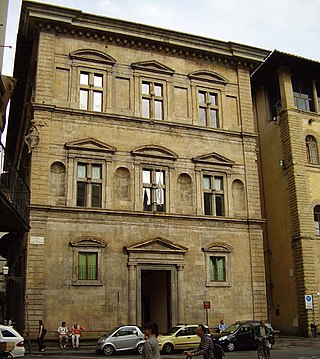
The Palazzo Bartolini Salimbeni is a High Renaissance-style palace located on Via de Tornabuoni on Piazza Trinita in central Florence, Tuscany, Italy.
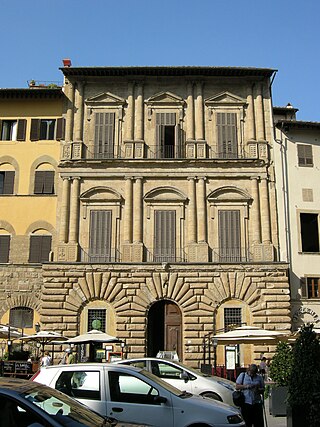
Palazzo Uguccioni is a Renaissance palace on the Piazza della Signoria in Florence, central Italy.

The Metropolitan City of Florence is an administrative division called metropolitan city in the Tuscany region, Italy. Its capital is the city of Florence. It replaced the Province of Florence. It was first created by the reform of local authorities and then established by the Law 56/2014. It has been operative since 1 January 2015.

The Casino Mediceo di San Marco is a late-Renaissance or Mannerist style palace located on Via Cavour number 57 and via San Gallo in Florence, region of Tuscany, Italy.

The Museo Horne is a museum focusing on art and furnishings of the 14th and 15th centuries, located in the former Palazzo Corsi, on via de' Benci number 6 in Florence, Tuscany, Italy.




















